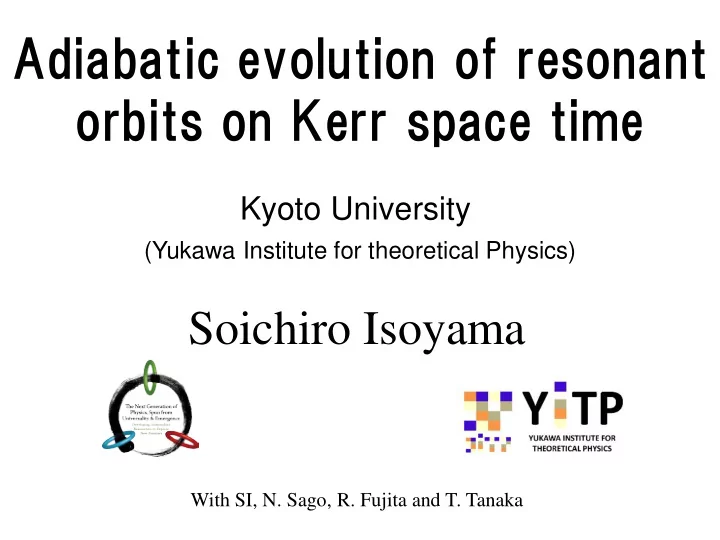

Adiabatic evolution of resonant orbits on Kerr space time Kyoto University (Yukawa Institute for theoretical Physics) Soichiro Isoyama With SI, N. Sago, R. Fujita and T. Tanaka
Extreme Mass Ratio Inspiral A compact object inpirals into a massive black hole: Promising sources of gravity waves (Tests GR etc...) Required: understand the evolution of general orbits on a Kerr black hole Kerr Property of Kerr geodesics 1. Three constants of motion Carter constant 2. Bi-periodic: Compact object [ from S.Drasco ]
Inspirals in “resonance” There is a special geodesic: resonant orbit The two orbital frequencies are no longer independent [A geodesic trapped in The dependence appears in resonance: from S.Drasco ] the difference between the origin of r and motion: :Non resonance How to understand the radiation reaction effects ?
Adiabatic approximation ( Timescale of radiation reaction ) ( Orbital period ) Leading orbital evolution with radiation reaction: Long time averaged change: Expand in the Fourier series: Oscillatory: not accumulate Accumulate for long time
For resonant orbits: There :is only one common frequency Oscillatory Accumulate for long time The term accumulating for long time is different Resonant orbits evolve quite differently. Calls for better understandings of resonance
Evolution of consts. of motion ・ Conservation laws with global Killing vectors Easy to compute via GWs flux. ・ There is no “Carter constant GW flux” thus… Needs Gravitational self-forces. ( Singular at particle location) Impossible to practical calculation for Kerr orbit, But…
Averaged value is still calculable in simple manner if the orbit is NOT in resonance [ Mino (2003), Sago+ (2005), Drasco+(2005)] Asymptotic amplitudes of GWs. at the infinity and at the horizon Our goal : Deduce the similar formula to compute the long time averaged evolution of the Carter constant even when the orbit is in resonance.
Toy model: scalar casae Simplify the discussion, use the scalar toy model as the first attempt. Gravitational case Scalar model Charge (mass) Charge (scalar) Filed (Linear perturbation) Filed (Scalar field)
Mode decomposition ・ Scalar field equation ( separable ): A bound orbit only excites discretized frequencies. Deduce the retarded solution via discrete mode sum Amplitude depends on an orbit Mode function
Evolution of the Carter constant ・ We return to the definition of the Carter constant With geodesic equations Note: the retarded field is singular at the particle location
Radiative and symmetric field With the advanced field, decompose the retarded field into two pieces: radiative and symmetric field Singular structure at particle location is common both in retarded and advanced field.: The radiative field is regular everywhere
Radiation reaction folmula The part from radiation field is essentially the same expression as the non resonant case, if . Calculable with asymptotic amplitude of scalar waves 1. Radiation field part (Regular piece) Some terms are modified fitting to the resonant case
Divergence in symmetric part In resonant case, the contribution from symmetric field exists. Diverges at particle location. 2. Symmetric field part (Singular piece) Only makes sense in the resonance case .
Avoid divergence, introduced point splitting regularization We can factorize the regularization terms. Rewrite symmetric part as the double Fourier series.
Mode sum Regularizations Read out physical information, we also need to subtract the singular portion from the symmetric field. T he singular portion can be “ smeared” by inverse above Fourier transformation We can subtract mode by mode, which are regular
Summary ・ We derive the formula for the long time averaged evolution of the Carter constant, applicable to a resonant orbit. ・ In the resonant case, the symmetric field also contributes the evolution of the Carter constant. ・ Despite the divergence in the symmetric field, we can control it via mode sum regularization.
糸冬 お疲れ様でした。
Evolution of consts. of motion [ Mino (2003), Sago+ (2005), Drasco+(2005)] ・ Conservation laws with global Killing vectors must always balance to GWs flux. ・ For the Carter constant, there is no Killing vector… Needs Gravitational self-forces. ( Singular at particle location) Impossible to practical calculation for Kerr orbit, But…
Radiation reaction formula [ Mino (2003), Sago+ (2005), Hinderer+(2008)] Retarded force and radiative force give the same long time average of the change of the Carter constant if and only if the orbit is off resonance . since the orbit is mapped to itself: Regular at particle location Asymptotic amplitudes of GWs. Numerically calculable formula [Drasco+(2005), Fujita+(2009)]
Recommend
More recommend